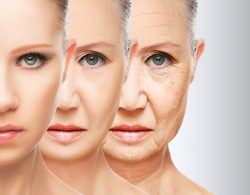
Dermal fibroblasts which are specialized cells that reside deep in the skin indicate how skin ages based on a study by the University of California San Diego School of Medicine. The team has discovered how our skin loses its ability to form fat during aging.
Dermal fibroblasts can convert into fat cells under the dermis which gives skin a youthful look and also produces peptides that will help fight infections. If the fibroblasts lose their ability to convert into fat, the skin is not able to fight infection effectively and the skin loses its more plump and youthful appearance.
A protein called transforming growth factor beta or TFG-B which controls many cellular functions within our body, stops dermal fibroblasts from their conversion into fat cells. It also prevents the cells from being able to produce the antimicrobial peptide cathelicidin which helps protect the skin from bacterial infections.
Babies have quite a bit of this type of fat under their skin which makes their skin very good at fighting some types of infections. With aging, dermal fibroblasts lose this ability to form fat under the skin. Skin that has this layer of fat looks more youthful. With the aging process, the appearance of the skin has a lot to do with this loss of fat.
Researchers used chemical blocks to inhibit the TGF-B pathway in mice. This caused the skin to revert back to a younger function which allowed dermal fibroblasts to convert into fat cells. If they turned off the pathway in mice through genetic techniques, they had the same result.
Understanding the biological process which leads to age related loss of the specialized fat cells could be used to help our skin fight infections such as Staphylococcus aureas. This pathogenic bacteria is the main cause of infections of the heart and skin and a significant factor in worsening diseases. When this particular infection becomes antibiotic resistant it then is known as methicillin resistant Staphylococcus aureas which is the leading cause of infection deaths in the U.S.
The team notes that eating a high fat diet is not the path to converting the dermal fibroblasts into fat cells. Obesity will also interfere with the ability to fight infections.
The next step for the researchers is to begin studying the infant’s immune system to obtain a firmer grasp of fibroblast development. They hope the results may also help them understand what goes wrong with other diseases.
To view the original scientific study click here:
Age-Related Loss of Innate Immune Antimicrobial Function of Dermal Fat Is Mediated by Transforming Growth Factor Beta





